Old School Modeling: Monogram 1/48 F-80C Shooting Star
HISTORY
The technological revolution in aircraft design and operation that resulted from the successful development of jet engines brought about more technological change in the five years between the end of World War II and the Korean War than any other comparable time in the history of aviation from the Wright Brothers' first flight. Supersonic flight was achieved a bit more than two years after the end of the war and the first fighter capable of controlled transonic flight saw action in Korea.
With the USAAF's first jet fighter, the P-59, a demonstrated operational failure by early 1943, the USAAF turned to Clarence “Kelly” Johnson and Lockheed Aircraft to solve the problem. The problem was made more urgent by the recent discovery through aerial reconnaissance of the existence of the German Me-262 fighter, which appeared ready to enter service within the next year. By this time, the AAF had been provided with the newly-designed Halford H-1B engine, which would become known as the “Goblin.” For the Air Force, time was of the essence. Kelly's special secret design unit that combined design and engineering personnel for the rapid creation of prototypes, which was already known as “The Skunk Works,” presented a concept for a single-engine air superiority fighter in April 1943. A design specification was written around the proposal and issued by the USAAF in May, 1943, with Lockheed presenting its detailed proposal for Project MX-409 30 days later. A contract for a single prototype was signed on June 17, 1943. Final design and production commenced on June 26. The project was so secret only the five managers of the 130 people working on it knew they working on the development of a jet aircraft. Security was so high that the British engineer who delivered the Goblin engine that fall was detained by police when Lockheed officials could not vouch for him. The prototype, known in the company as “The Green Hornet” for its RAF dark green paint scheme and nicknamed “Lulu Belle,” was trucked to Muroc Field from the Lockheed factory in Burbank on November 16, a remarkable 143 days from commencement of work. The engine was mated to the airframe, only to be destroyed by foreign object damage during the first run-up. There was only one other Goblin engine in existence, which delayed the first flight until it could be removed from the first deHavilland Vampire prototype and delivered from Britain
The prototype, now known as the XP-80, was displayed to Air Force commanders at Muroc on January 8, 1944. Lockheed Chief Engineering Test Pilot Milo Burcham made the first flight. The jet roared down Muroc's Runway 23, lifted off, then quickly landed when the landing gear failed to retract. Lockheed's technicians quickly fixed the electrical problem and Burcham started up again and soared into the clear California winter sky. Over the next hour, he gave the assembled audience an air show in which he clearly demonstrated the wonderful flying characteristics the P-80 would become known for in service.
The XP-80A was designed for the larger General Electric I-40 engine (an improved J31, later produced by Allison as the J33). Two aircraft, 44-83021 and 44-83022, were built to test this configuration. 44-83021 was nicknamed “The Gray Ghost” for its "pearl gray" paint scheme, while 83022 was left unpainted for comparison of flight characteristics and became “The Silver Ghost.” The XP-80As' airframe was larger and 25% heavier than that of the XP-80. Initial opinions of the airplane were not positive. Milo Burcham commented after several flights that an aircraft he very much enjoyed when powered by the Halford engine had become a "dog." Further tests revealed the engine was not getting enough air to produce full power. Modification to the air intakes to improve boundary layer control resulted in the engine maintaining full power, which restored the flight characteristics of the Green Hornet.
On October 20, 1944, Burcham was killed while flying the third YP-80A (44-83025) when the engine flamed out on takeoff due to fuel starvation. His death resulted from the failure to brief him on a newly installed emergency fuel pump backup system that would have prevented the failure. On March 25, 1945, newly-promoted Chief Engineering Test Pilot Tony LeVier was forced to bail out of The Gray Ghost when one of the engine's turbine blades broke and caused a structural failure in the aircraft's tail. LeVier broke his back when he landed hard and only returned to the test program after six months of recovery.
Jet aviation continued to create fatalities. On August 6, 1945, Major Richard Bong, the top-scoring USAAF ace, was killed during the acceptance flight of a production P-80 when the engine failed on takeoff as had happened to Burcham. When the aircraft rolled inverted, Bong bailed out but he was too close to the ground for his parachute to deploy. The investigation of Bong's crash found he had forgotten to switch on the emergency fuel pump, which could have prevented the accident. The pre-takeoff check-off list was changed to insure the pilot turned on the emergency pump before engine start-up.
Lockheed eventually built a total of 917 F-80As and Bs. These were followed by the P-80C, which began production in 1948, its designation changed on June 11 to F-80C when the newly-independent Air Force changed designators to F-for-fighter rather than P-for-pursuit. This sub-type differed from the P-80A and B in having a wing of thinner section and a more powerful Allison J33-A-35 giving 4,600 lb S.T. dry thrust, which could be increased to 5,400 lb S.T. with water injection. Top speed increased to 594mph (Mach 0.76) at sea level and rate of climb increased to 6,870 fpm. The F-80C was also the first Air Force fighter to have an ejection seat installed at the factory. Production ended in 1950 with 162 P-80C-1-LO, 75 P-80C-5-LO and 561 F-80C-10-LO production blocks in addition to 129 F-80As upgraded to F-80C-11-LO standard.
The F-80 in Korea:
On June 27, 1950, the F-80 entered combat when a flight of four F-80s protecting the evacuation of American personnel from Seoul spotted four North Korean Il-10s and shot them down. The fighter was of limited use in the first 90 days of the war, since it could not operate from unpaved runways in Korea. Following the Inchon invasion in September, the F-80s began operating from the paved runways at Kimpo and Suwon in South Korea.
On October 31, 1950, the air war in Korea suddenly changed. That morning, F-80 pilots of the 51st Fighter Interceptor Wing's 25th squadron reported they had seen “silver, arrow-shaped jets” in flight over the major airfield at Antung, just across the Yalu. A few hours later, Captain Alma R. Flake led a flight of 67th Fighter-Bomber Squadron F-51D Mustangs on a sweep to the Yalu. They spotted “unknown enemy jet aircraft” on the Manchurian side of the border. Though he was unable to close the enemy fighters, Flake still fired his guns in an attempt to obtain gun camera film of the strange jets. Once his film was developed back at base, it was found he had gotten some fairly-distinct shots of what were tentatively identified as MiG-15s, the newest Soviet jet fighter. The film went all the way to FEAF headquarters in Tokyo and eventually provided the evidence for FEAF commander General Stratemeyer to convince the Air Force high command to release the Sabres of the 4th Fighter Interceptor Wing for service in Korea to meet the new threat.
On November 1, 15 F-51s of the 67th squadron were intercepted as they came off bombing the Sinuiju Yalu bridge by five MiG-15s. The Americans didn't know these enemy jets were from the 1st Squadron of the 72nd GvIAP (Gvardeyskiy Istrebetelnaya Aviatsonniy Polk - Guards Fighter Air Regiment) of the Soviet Union's Venno-Vozdushney Sily (V-VS, the Red Air Force), led by Hero of the Soviet Union (HSU) Major N.V. Stroykov, a 16-victory Soviet ace of the Great Patriotic War (World War II), leading Senior Lieutenants Guts and Kaznacheev and Lieutenants Monakhov, Chizh and Sanin. At first, the Americans were able evade the faster jets by turning sharply, a maneuver the jets couldn't follow. Eventually, one F-51D broke from the others and Lieutenant Chizh, a 13-victory Great Patriotic War ace, shot it down. First Lieutenant. Aaron Abercrombie became the first American victim of the new arrivals, though his loss was officially credited to ground fire by the Air Force until Soviet records were opened in 1992, following the end of the Cold War.
Shortly after noon, an 8th Tactical Reconnaissance Squadron RF-80A radioed that he had spotted 15 NKAF Yak-9Ps on the Sinuiju airfield and in response General Stratemeyer ordered the 49th wing to strike the airfield. Twelve F-80s with strict orders not to violate the Yalu border were launched to hit the airfield. Shortly after they arrived over Sinuiju at around 1545 hours, the pilots received a radioed warning of “bogeys” in the vicinity. Moments later, at 1550 hours, the lead flight of four F-80s was hit by three MiG-15s led by 72nd GvIAP 1st Squadron commander Major Bordunthat with Senior Lieutenant Khominich and Lieutenant Sukhov, that dived out of the sun through their formation. Senior Lieutenant Semyon Fyodorovich Khominich put the MiG's heavy armament to good use by exploding the Shooting Star flown by 1st Lt. Frank Van Sickle. A Soviet pilot had emerged victorious in history's first jet vs. jet air combat. USAF records admitted the loss of two F-80Cs on November 1: Van Sickle's from the 49th, and another from the 51st group listed as lost during a rocket attack near Unsan that afternoon, shot down by other MiGs. These two losses were officially credited by the USAF to North Korean anti-aircraft fire until Russian records that became available after the end of the Cold War revealed the truth.
Over the next four days, UN ground forces were hit by massed units of the Chinese People's Volunteer Army, which was in North Korea numbering some 300,000 troops despite General MacArthur's stated belief that there were no more than 40,000, intent on a limited incursion to “save face” as the North Koreans retreated. When the Eighth Army failed to hold on at Unsan on November 4 and the Marines barely held on at Sudong on November 6, MacArthur went from full confidence to full panic. The general was thought of by those who worked with him or confronted him during the 45 years of his career as having two speeds: “When he was good he was brilliant, and when he was bad he was terrible, and there was no in-between” as one senior officer recalled. He requested permission to bomb the Yalu bridges, truly a case of closing the barn door after the horse was gone since the Chinese were already in North Korea in overwhelming force. President Truman reluctantly agreed.
The first mission against the bridges was scheduled for November 7, but was canceled due to bad weather. With a forecast of better weather, the mission was rescheduled for the following day. Major Evans G. Stephens, commander of the 16th Fighter Interceptor Squadron of the 51st Fighter Interceptor Wing, later remembered that November 8, 1950, was remarkably bright and clear, a day different from most in Korea, where fliers regularly contended with bad weather. Flying at 18,000 feet, ceiling and visibility were unlimited, and the Korean countryside far below was already snow-covered in the outset of what would later be recorded as the coldest Korean winter in 144 years. Squadron pilot 1st Lieutenant Chester Wagner later described Stephens to historian Robert Dorr as “the best commander I ever had, a natural stick. He could handle an F-80 better than anybody I ever saw.” As the fighters continued toward the Yalu, Stephens glanced out at his wingman, 1st Lieutenant Russell J. Brown, flying F-80C 49-713. Brown was normally assigned to the 25th squadron, but was on temporary assignment to the 16th to provide the benefit of his experience for the newer pilots. The fighters' assignment was escort to B-29s bombing the Sinuiju railroad bridge.
Stephens later described what happened. “When I saw there was no enemy air opposition, I led my flight down to attack the enemy flak positions.” He and Brown made the first run. The defending flak was heavy, and most of it was coming from across the river on the Manchurian side. "We could have got out and walked on it." Stephens and Brown climbed to cover First Lieutenants Ralph N. Giel and Richard D. Escola on their attack. At that moment, they heard a call from pilots escorting the B-29s that MiG-15s had been sighted crossing the Yalu from Manchuria. Stephens quickly spotted eight MiGs approaching from the south and above, on the South Korean side of the river, and ordered Giel and Escola to break off their run and join up.
The B-29s made their attack before the MiGs could arrive, with 61 bombers dropping 580 tons of incendiaries on the city, which burned most structures to the ground, while the remaining nine bombers dropped 500-pound high explosive bombs on the Yalu bridge, though they only succeeded in damaging the road to the bridge rather than the structure itself. Their task completed, the bombers turned south and headed back to Okinawa.
Minutes later, MiG-15s flashed past Stephens' flight and he saw two of the jets pull out of their dive and head toward the Antung airfield complex across the river, at the same altitude. Stephens banked sharp left to pursue them and he got the enemy flight leader in his gunsight. “I thought I could get him, but I didn't want to punch off my wing tanks for fear they might hit the two inexperienced pilots in my flight.” Stephens banked sharply to the left with wingman Brown closely behind. Brown still had not spotted the enemy, and recalled afterwards, "I was looking around like mad and flying formation at the same time." As Stephens completed his turn, Brown saw the two MiGs when the wingman turned right in front of him.
The enemy leader climbed to the left to disengage, while the wingman turned right. Brown stayed tight inside his turn. Three of his six .50-caliber guns had jammed on the strafing run, but he managed to fire four short bursts that missed.
Lieutenant Karitonov, the enemy pilot, then winged over into a dive and Brown went after him. As the two fighters hurtled straight down, Brown popped off his wingtip fuel tanks to lighten his fighter and increase its speed and closed to within 1,000 feet of the MiG. He fired one long burst during which two of his three guns jammed, following that with three short bursts from his last gun. As he did, he thought to himself, “Damn, I'm going to get him.” The MiG appeared to catch fire near the engine. "It was now or never, I squeezed the trigger and held it down."
Brown's Shooting Star was buffeting as he dove at more than 600 mph, past the F-80's limiting Mach number and nearly out of control. He reduced the throttle and pulled back hard on the stick. With a final burst, he saw explosions on the ground. G-force streamers spread from the wing tips as Brown managed to pull out of the wild dive a hundred feet above the ground and head back for altitude. So far as the USAF was concerned, Russell J. Brown had just scored the first jet vs. jet kill. The victory had been due to luck, since the enemy pilot could have easily outrun the F-80 had he climbed instead of dived and applied throttle in time.
In fact, Lieutenant Kharitonov was not splattered across the Korean countryside. As Brown had done, he had dropped his two underwing tanks in the dive to lighten his fighter. There was a light haze at this lower altitude, which limited Brown's view of the MiG and he mistook the falling drop tanks for pieces coming off the enemy fighter. Kharitonov had just become the first Soviet pilot to release his drop tanks in combat; there were only a limited number of them available in the units at this time, which made each worth its weight in gold. Pilots were ordered to put up with inferior flight characteristics with the tanks in order to prolong their time in the combat zone.
Brown had identified the plumes of burning kerosene from the falling tanks as the MiG catching fire, reinforcing the illusion in the haze that he had mortally wounded his adversary. In truth, the MiG was so hardy that the weight of fire of one .50 caliber machine gun would only have been fatal had there been a “golden BB” hit on something vital. Kharitonov pulled out of his dive so low his exhaust rippled the trees below and he stayed low as he streaked across the Yalu. While Brown was climbing to rejoin the others and reporting his success, his opponent was lowering his landing gear and dropping onto the main runway at Antung.
To this day, despite the Soviet records of the engagement having been available since 1993, the USAF official history page lists Russell J. Brown as the first jet pilot to shoot down another jet. The Korean War truly is “the forgotten war,” and 69 years of unquestioned wartime propaganda has solidified like a coprolite into “historical fact.”
A month after this event. The F-86 Sabres of the 4th Fighter Group would arrive in Korea, changing the air war. The F-80 would see service as a fighter-bomber until its replacement by F-86F-25 fighter bombers in the spring of 1953.
THE KIT
Monogram's F-80 Shooting Star was first released around 1976, part of a trio of Korean War jets, the others being the F-86F Sabre and the MiG-15bis. 43 years later, Monogram's now-ancient kit is still the only accurate F-80 kit available in 1/48. In 2017, Hobby Boss released an F-80 kit that is completely botched by air intakes that are 25% too large, as well as dimensional inaccuracies. The Monogram kit is outline accurate, and within an inch of “on the nose in both length and wingspan.
The kit is from that maddening period of the mid/late 70s when Monogram was owned by a company that made car kits, whose CEO had so little understanding of airplane kits that he believed withdrawing the P-51B from production would result in more sales of the newer P-51D, since “A P-51 is a P-51.” The F-80, F-86 and MiG-15 were “produced for a price,” and it shows in poor fit of parts and decals that are cheap, thick, inaccurate and overall unusable in all varieties of the kits that have ever been released.
Fortunately, SuperScale and Aeromaster released several F-80 aftermarket decal sheets that are quite accurate and allow a modeler to do everything from the early P-80As through the F-80C.
CONSTRUCTION
I decided to do this when I got my most recent e-mail newsletter from the Rare Plane Detective, and saw this there at a price of $25, postage included delivered, and decided to make another addition to my collection of Korean War airplanes.
The kit is old-school simple with around 40 parts, of which about 37 are used depending on which sub-type one is making.
I began by attaching each rear fuselage half to the forward fuselage half. Once the Tamiya Extra-Thin cement had set up, I reinforced the joints on the inside with CA glue. I then attached the intakes and their splitter plates to each fuselage half, and finished by gluing the open gun bay door on the left side closed.
I then cut off the tabs on the dropped flaps and glued them to the lower wing in the closed position. I reinforced this joint with some Evergreen sheet on the inside, and filled the gaps between the flaps and the wing inboard and outboard with CA glue applied from inside. When that had set up, I assembled the wing sub-assembly.
I then painted and detailed the cockpit tub and attached it. I filled the nose with fishweights and then attached the engine to the right fuselage half. I finished off by assembling the fuselage; I cut off the locating pins so I could carefully get the best fit possible overall.
The wing was then attached to the fuselage, and the horizontal stabilizers were attached. When all had set up, I filled all the gaps - fuselage centerline, wing/fuselage gaps, etc., with CA glue. When that was set, I engaged in an afternoon-long sanding and smoothing process, using around 10 different sanding sticks of varying grit to get the model as smooth as possible, then put about 20 minutes into polishing it overall, re-sanding with fine grit pads wherever I came across scratches, till all was smooth. I then rescribed the raised panel lines with a #11 blade.
COLORS & MARKINGS
I first misted on a thinned coat of Tamiya X-18 Semi-Gloss Black as a primer for the Vallejo metal paint to grab. Color photos of F-80s reveal the airplane was primarily one type of aluminum, with some various panels in a lighter shade. I painted the model overall with Vallejo Aluminum, then brush-painted part of the rear fuselage and some other areas with White Aluminum. The nice thing about Vallejo metal paint is that, after you have the primary color on and dried, you can brush-paint other colors on, and when the paint dries there are no brush marks - this means you don't have to risk pulling up paint by masking.
The SuperScale F-80 sheets and the Aeromaster sheets are not that widely available and command pretty good prices on the net, but I was able to find SuperScale 48-163, which had F-80Cs from the 51st FIW and 8th FBW in 1950, that was at a good price. After the vendor survived Hurricane Dorian, I got the decals and spent an afternoon doing “Saggin' Dragon” of the 16th FIS, 51st FIW, one of the airplanes involved in the November 8, 1950 fight with the MiGs. The decals went on faultlessly. I used the excellent Fundekals National Insignia sheet (highly recommended - every version of US national insignia from 1943-65, properly proportioned in the correct colors) for the stars and bars.
I glued the clear canopy to the silver frame using Micro Krystal Klear white glue, which filled the gaps and dried invisible. The seat was finished using Eduard photo-etch seatbelts and installed, with the canopy positioned open. I attached the main gear and the underwing bomb pylons. I used two 75 gallon drop tanks from the Eduard P-51D painted yellow as napalm tanks.
CONCLUSIONS
Success with this kit requires dusting off and applying some WD-40 to the Old School Modeling Skills, which are definitely needed. This was a nice trip in the Wayback Machine to recall how lucky we are today with modern kits. With effort, this old kit can still be turned into a nice addition to your Korean War collection.
REFERENCES
Historical section from my coming book: “MiG Alley: The U.S. Air Force in Korea, 1950-53,” available for pre-order now to be released November 16.
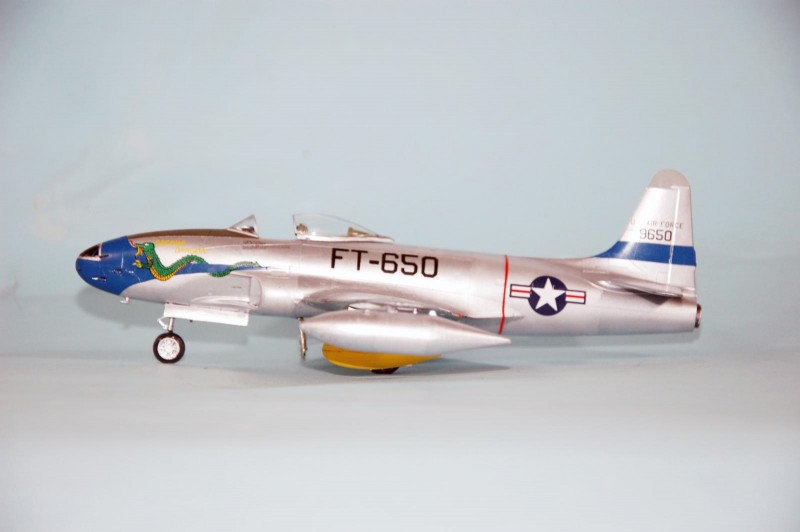
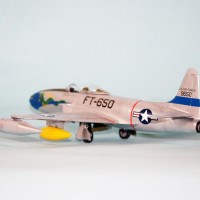
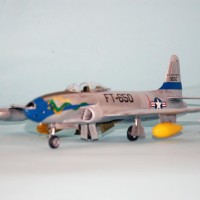
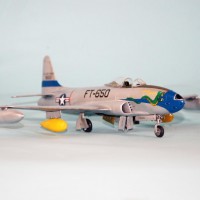
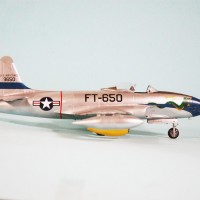
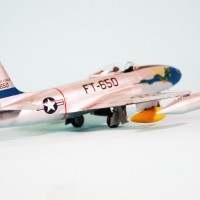
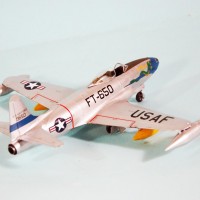
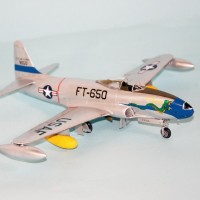
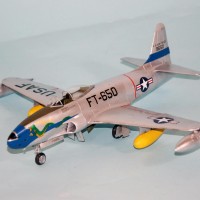
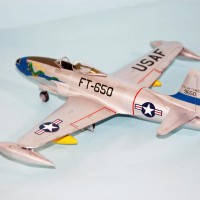
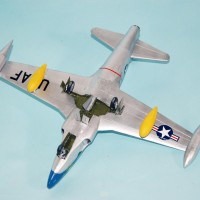
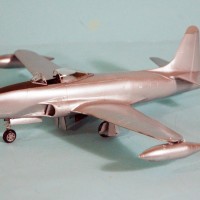
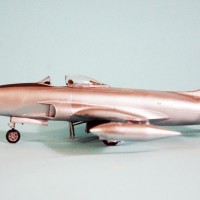
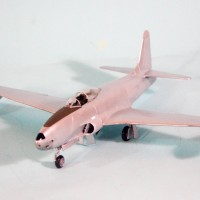
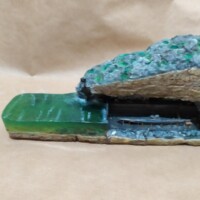
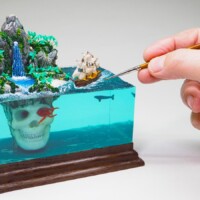
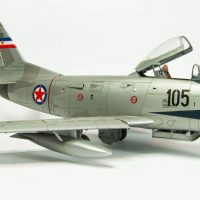

As always, an enjoyable history and informative build.
Once again a comprehensive background to your build. Thanx for sharing. Will have to put the book on my wishlist for my birthday (by coincidence the date of release)
Nicely presented and finished, TC...good-lookin' build.
Nice!
Great looking F-80 Tom. A new tune can indeed be played on an old fiddle. These old Monogram kits just need a lot of TLC to build into awesome models.
Great looking model Tom! And an instant flashback from long ago. And thanks for the history lesson too.
nice job...heard it's a toughy
Hello Tom,
You did put a lot of time in this presentation and that's much appreciated. The model looks great, as most Monogram models do.
Talking about long lasting "T" types: In July 2017 the Bolivian Air Force retired the last T-33, that was taken over second hand from the CAF in 1973. Only a few examples left in civilian hands.
As the saying goes: "They do not make them like that anymore."
Regards, Dirk The Netherlands.
Nice-looking F-80 and interesting history as well!
Hi Tom, got a question regarding your F-80 build that you published in 2019.
Your Shooting Star has wing tip fuel tanks AND what looks like additional fuel tanks(in yellow) where usually bombs are hung.
Are these indeed additional fuel tanks, or possibly napalm?
squadron's F-80 In Action book also has F-80s on the cover in this configuration but gives no explanation - hoping you can enlighten me.
Building a Monogram F-80 right now . . .